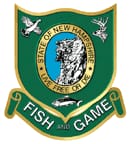New Hampshire Fishing Report for August 31, 2012
OutdoorHub 08.31.12

NORTH COUNTRY
It seems odd to think that the water may be too warm for bass fishing. In reality, there are preferred temperature regimes for bass, and some sections of a waterbody may be too warm. The direct result is that small and largemouth bass may be easier to find as they seek this desired refuge. Last week, Lake Umbagog had a surface temperature of almost 80 degrees. Even though this lake covers nearly 8,000 acres, the average depth is 12 feet, and deep, cool water was hard to find. I started fishing tube baits and deep-running crank baits that were sure to find the bottom. I fished slow retrieves and covered a lot of water. The fish were not there.
I looked for some aquatic vegetation that had held fish in June and July. The growth is dense and stops just short of the surface of the lake. Typically a great place for a surface lure, I started casting a white, lipless pencil bait and retrieved it in a jerky, walk-the-dog style motion. The fish were not there. My next approach was a slow-moving plastic swim bait. A wide gap hook with lead on the shank gives these baits a natural, sinking look, and I have enjoyed catching bass on them in the past. I threw them near structure and around boulders. The fish were not there.
After discovering so many locations where fish were not spending their day, I decided to change tactics completely. After all, fishing the same way with no results is a common mistake and can admittedly be a hard pattern to break. One of the rivers that feeds into Lake Umbagog is the Magalloway. I have studied the temperature profiles of this river extensively, as an ongoing brook trout telemetry project sends me there frequently. This cool influx of water seemed like my last hope for the day. I started with a red and white spinnerbait and made long casts paralleling the river and its current. The results were almost immediate. I started catching smallmouth in the 12 to 16-inch range and was able to salvage an otherwise fishless day. There was also a sense of pride in having success after so many failures. – Andy Schafermeyer, Fisheries Biologist
LAKES REGION
Our current dry weather spell has certainly reduced stream flows throughout the Lakes Region. Lake levels continue to drop, and the alewives in Winnisquam continue to feed at dusk in the large bay that my house is situated on. Salmon, lake and rainbow trout have been feasting on these alewives, and if history is correct, they could still be in the system right through the end of September. Try trolling small Mooselook wobblers (copper/silver) or Yozuri pin minnows to imitate these herring. I’ve seen schools of these herring on my depth sounder, generally 20-40 feet down.
I still find Hexagenia mayflies on my dock in the morning on Lake Winnisquam. Lake temperatures (surface) are still in the upper 70 degree range. This is the time of year that lake trout and landlocked salmon are building up their body condition by feeding ravenously on juvenile smelt and occasionally on white and yellow perch that are found in the various levels of the thermocline. Salmon and trout are in a “pre-spawn” mode now, as their eggs/milt mature for fall spawning.
During the past few seasons, we have noted a serious “shift” in our landlocked salmon at this time of year. This shift finds the salmon “running” the shores in anticipation of fall spawning. The last few years, I have witnessed salmon repeatedly leaping clear of the water along the shores of Winnipesaukee, especially along the sand flats off Ellacoya State Park, and down the Gilford shoreline as well. It is quite a sight to see these salmon performing their pre-spawn rites, as they are in water less than 5 feet deep, in schools of up to 7 or 8 fish!
At this time the “bite” off shore definitely drops off, for salmon at least. Rainbows will continue to be found off shore, and down into the thermocline. Lake trout also feel the urge for spawning, although their time is still over two months away. Lakers will be found congregating in the mid-levels of the deep basins in Lake Winnipesaukee. I remember a few seasons ago, I trolled the area off Black Point in Winnipesaukee for salmon and lake trout. We did well on lakers with Sutton spoons size 5 and 61, copper/silver. The trick at this time of year, and one I employed, was to troll with 7 colors of lead core line, and frequently shift the motor into neutral, allowing the lures to slowly descend into the depths. The fluttering action of the Sutton spoons was too much for the lake trout, as we caught several doubles, especially as the motor was returned to gear, and the boat began to travel forward. Try this technique over deep basins, and time your drops. — Don Miller, Fisheries Biologist
SEACOAST AREA
It’s been quiet on the coast lately, with bursts of action from bluefish. But don’t fret; shellfishing season is right around the corner! Oysters open on September 1st and softshell clams open the day after Labor Day (except in Hampton/Seabrook estuary). Get your licenses and know the open areas. Some areas are closed due to pollution concerns; you can find a map of the open/closed areas on pages 24 and 25 of the current Saltwater Fishing Digest. All open areas may be temporarily closed due to bacterial or red tide concerns, so call 1-800-43-CLAMS before heading out to get the current status. While you are out there, remember there is no closed season on blue mussels. – Becky Heuss, Marine Biologist

